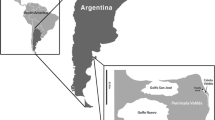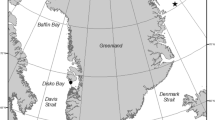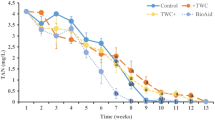Abstract
Using aquatic worms (Oligochaeta: Tubificidae) for oil decontamination of bottom sediments has been first considered. In a set of experiments on Limnodrilus hoffmeisteri Claparede, 1862, worms survived the exposure to oil content as high as 16.72 g/kg; they died of natural causes. Vigorous silt agitation by worms (bioturbation) was observed: the silt layer thickened as compared with that in reference aquaria without worms. Besides, it tended to thicken with increasing oil content of sediments. Within 30 days Limnodrilus hoffmeisteri reduced oil content by 1.20 to 1.72 times, or by 16.67 to 41.90% (a<0.05), compared with that in reference aquaria.
Similar content being viewed by others
References
S.V. Lushnikov, D. S. Vorob’ev, and V. N. Fadeev, “Decontamination of Bottom Sediments: First Step Taken,” Ekologiya i Promyshlennost’ Rossii, No. 9, 30 (2005).
S. V. Lushnikov and D. S. Vorob’ev, “Oil Decontamination of Bottom Sediments: Experimental Work Results,“ Ekologiya i Promyshlennost’ Rossii, No. 10, 11 (2006).
S. A. Ostroumov, “Basic Functional Components and Energy Sources of Biotic Mechanisms of Self-Purification of Water in Ecosystems,” Ekologicheskie Sistemy i Pribory, No. 7, 19(2006).
D. S. Vorob’ev, “Influence of Oil and Petroleum Products on Macrozoobenthos,” Izv. Tomsk. Politekh. Univ., No. 3, 42 (2006).
V. I. Popchenko and T. V. Popchenko, “Resistivity of Oligochaeta to Chemical Pollution,” Izv. Samar. Nauchn. Tsentra Ross. Akad. Nauk, No. 2, 201 (1999).
G. Alsterberg, “Die respiratorischen Mechanismen der Tubificiden,” Lunds Univ. Aarsskr. N. F. J. D. Avd. 2.18(1) (1922).
T. L. Poddubnaya, “Materials on Feeding of Mass Turbificid Worms of Rybinsk Reservoir,” Trudy Inst. Biologii Vodokhranilishch 4(7), 219 (1961).
L. I. Tsvetkova, “Effect of Saprobe Oligochaetes in Oxygen Balance of Water Bodies (Neva River Basin),” Candidate’s Dissertation in Biology (Leningrad, 1969).
R. O. Brinkhurst and M. J. Austin, “Assimilation by Aquatic Oligochaeta,” Int. Revue ges. Hydrobiol. 64(2), 245 (1979).
R. O. Brinkhurst and K. E. Chua, “Preliminary Investigation of the Exploitation of Some Potential Nutritional Resources by Three Sympatric Tubificid Oligochaetes,” J. Fish. Res. Board Can. 26 (10), 2659 (1969).
S. L. Whitley and T. N. Seng, “Studies on the Bacterial Flora of Tubificid Worms,” Hydrobiologia 48(1), 79 (1976).
M. Wavre and R. O. Brinkhurst, “Interactions between Some Tubificid Oligochaetes and Bacteria Found in the Sediments of Toronto Harbour, Ontario,” J. Fish. Res. Board Can. 28(3), 335(1971).
R. O. Brinkhurst, K. E. Chua, and N. K. Kaushik, “Interspecific Interactions and Selective Feeding by Tubificid Oligochaetes,” Limnol. Oceanogr. 17(1), 122 (1972).
M. V. Martynova, “Effects of Some Benthic Organisms of Denitrification and Dephosphatization in Bottom Sediments,” Gidrobiologicheskii Zh., No. 6, 44 (1985).
L. I. Tsvetkova, “Aquatic Oligochaeta (Systematics, Ecology, Studies of the USSR Fauna),” Trudy Vses. Gidrobiol. Obshch. 17, 118 (1972).
S.A. Gerlakh, Marine Pollution. Diagnosis and Therapy (Gidrometeoizdat, Leningrad, 1985) [in Russian].
Author information
Authors and Affiliations
Corresponding author
Additional information
Original Russian Text © D.S. Vorob’ev, Yu.A. Frank, S. V. Lushnikov, N.A. Zaloznyi, Yu.A. Noskov, 2010, published in Sibirskii Ekologicheskii Zhurnal, 2010, Vol. 17, No. 1, pp. 21–26
Rights and permissions
About this article
Cite this article
Vorob’ev, D.S., Frank, Y.A., Lushnikov, S.V. et al. Oil decontamination of bottom sediments using Limnodrilus hoffmeisteri (Oligochaeta: Tubificidae). Contemp. Probl. Ecol. 3, 15–18 (2010). https://doi.org/10.1134/S1995425510010042
Published:
Issue Date:
DOI: https://doi.org/10.1134/S1995425510010042




